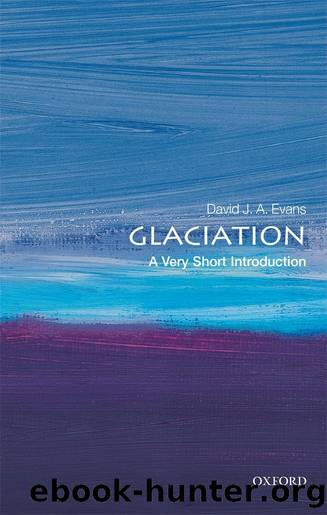Glaciation by David J. A. Evans

Author:David J. A. Evans [Evans, David J. A.]
Language: eng
Format: epub
ISBN: 9780191062995
Publisher: OUP Oxford
Published: 2018-08-22T00:00:00+00:00
Glacial deposition and subglacial deformation
Vast areas of the Earthâs surface and its ocean beds have been affected by glacial deposition, well beyond the maximum margins of former glaciers. It is convenient to divide depositional processes into those that operate on land (terrestrial or subaerial) and those under water (subaqueous). Generalized terms have been used to designate glacial deposits on maps of the Earthâs surface, including drift, boulder clay, till, and raised glacimarine sediments, but such classifications hide a multitude of complex characteristics and can often be somewhat inaccurate. Nevertheless, their coverage and thickness is significant and a glacigenic classification implies a specific set of former depositional processes. But contemporary glacier beds and floating ice/deep water interface zones are very difficult environments to access, so how much do we really know about these processes?
After the discovery of the subglacial deforming layer in the late 1970s (see Chapter 2) it was clear that direct glacial deposition was inextricably linked to the deformation process, but we should not really include deformation under a compilation of depositional processes because in a strict sense it is not a form of primary deposition but instead the secondary modification of existing deposits. Nevertheless, more than a century of research on the genesis of till has resulted in a plethora of often confusingly overlapping and apparently contradictory, process-related terms for till and associated sediments and it has become common procedure to include subglacial deformation in process-form discussions on glacial deposits.
To keep it simple we can identify three interrelated and cooperating subglacial processes, whose relative dominance may switch in space and time. First, melt-out is the release of debris from the glacier as it melts so that the material is deposited in cavities at the iceâbed interface, where it inevitably becomes subject to further reworking. Second, lodgement takes place where individual clasts are arrested at the bed due to their frictional drag, which eventually overcomes the tractive force or shear stress imparted by the ice motion. Third is bed deformation, which is involved in the creation and transport of all subglacial till but is nourished by melt-out and/or cannibalization (thrusting, folding, kneading, pinching, dislocation, and rafting) of the substrate. At any stage, individual clasts can plough through the deforming layer or the substrate and as a consequence their forward movement is arrested and they become lodged. The deforming layer may also thicken over time, especially near glacier margins where basal shear stresses drop, thereby leading to glacier sub-marginal till thickening, a process also manifest in the production of push moraines (see Chapter 6).
It has been suggested by geologists that the easiest way to think of the subglacial till-forming environment is as a fault gouge or shear zone in which material is constantly generated by the brecciation, mixing, and homogenization of material derived from the substrate, with extra material being input from ice melt-out. A till is only deposited once all deformation stops, even though components of the till (i.e. large clasts or boulders) may become lodged at any time (Box 8).
Download
This site does not store any files on its server. We only index and link to content provided by other sites. Please contact the content providers to delete copyright contents if any and email us, we'll remove relevant links or contents immediately.
| Africa | Americas |
| Arctic & Antarctica | Asia |
| Australia & Oceania | Europe |
| Middle East | Russia |
| United States | World |
| Ancient Civilizations | Military |
| Historical Study & Educational Resources |
The Boy, the Mole, the Fox and the Horse by Charlie Mackesy(2957)
Fatal Storm by Rob Mundle(2146)
Iced In by Chris Turney(1937)
Erebus by Michael Palin(1789)
Alone by Richard E. Byrd(1660)
The White Darkness by David Grann(1652)
South with the Sun by Lynne Cox(1519)
Mawson's Will by Lennard Bickel(1394)
Big Dead Place: Inside the Strange and Menacing World of Antarctica (Large Print 16pt) by Nicholas Johnson(1345)
Caroline Alexander by The Endurance: Shackleton's Legendary Antarctic Expedition(1338)
The Stowaway by Laurie Gwen Shapiro(1323)
South by Ernest Henry Shackleton(1322)
South Pole by Elizabeth Leane(1249)
In the Kingdom of Ice by Hampton Sides(1233)
The Ice Master by Jennifer Niven(1200)
A Farewell to Ice: A Report from the Arctic by Peter Wadhams(1192)
Ice by Unknown(1186)
The Ice Balloon: S. A. Andree and the Heroic Age of Arctic Exploration by Wilkinson Alec(1170)
Frozen in Time by John Geiger & John Geiger(1159)
